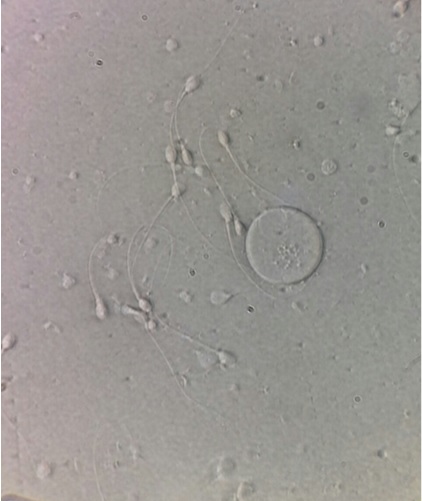12.1 Introduction to Male Reproductive

Figure 12.1 Human sperm cells. Sperm cells, the male gamete, fertilize the egg cell, the female gamete, to create a new human. Oblique X 1000 (Micrograph provided by Stojanovic23, CC BY-SA 4.0 , via Wikimedia Commons)
Learning Objectives
After studying this chapter, you will be able to:
- Describe the anatomy of the reproductive systems, including their accessory structures.
- Explain the role of hypothalamic and pituitary hormones in reproductive function.
- Trace the path of a sperm cell from its initial production through maturity.
- Describe the development and maturation of the sex organs and the emergence of secondary sex characteristics during puberty.
Introduction
In social settings, the words “female” and “male” are regularly used to describe two different concepts: our sense of gender identity, and our biological sex as determined by our X/Y chromosomes, hormones, sex organs, and other physical characteristics. For some people, gender identity is different from biological sex or their sex assigned at birth. In this chapter and the next chapter, “male” and “female” refer to sex only, and the typical reproductive anatomy of XX and XY individuals is discussed.
Louisiana Lagniappe
A procedure unique to the anatomy of the male reproductive system is circumcision. During circumcision, the prepuce (foreskin) is removed from the penis. While circumcision can be performed at any time between birth and adulthood, the procedure remains a controversial one, particularly considering circumcision in newborns. Though ultimately unsuccessful, legislation has been proposed to prevent circumcision procedures from being performed on children.
There are many factors that contribute to the parental decision of whether or not to have a child circumcised. The American Academy of Pediatrics (AAP) formed a task force which released an official statement regarding circumcision in 2012. It was found that health benefits related to the procedure outweigh any potential complications of circumcision. The AAP Task Force found that the risk of urinary tract infections (UTIs) is lower in circumcised newborns and infants and the risk of transmission of human immunodeficiency virus (HIV) and other sexually transmitted infections (STIs) once an individual becomes sexually active. Even with these findings, however, the AAP maintains that the decision of whether or not to circumcise a child should remain one that is made by guardians under the advice of their healthcare provider.
Though there appear to be benefits associated with circumcision, rates of circumcision have decreased over recent decades. According to the Centers for Disease Control and Prevention (CDC), 64.9% of newborns in the United States were circumcised in 1981, while only 55.4% were circumcised in 2007. Currently, the largest determinants of guardians deciding to circumcise a child are health and the presence of a circumcised father or brother. In Louisiana, 45% of male newborns who are born in hospitals are circumcised before being discharged, according to World Population Review. This may be due to availability of insurance coverage, as Legacy Medicaid only covers circumcisions deemed to be medically necessary in the state.
